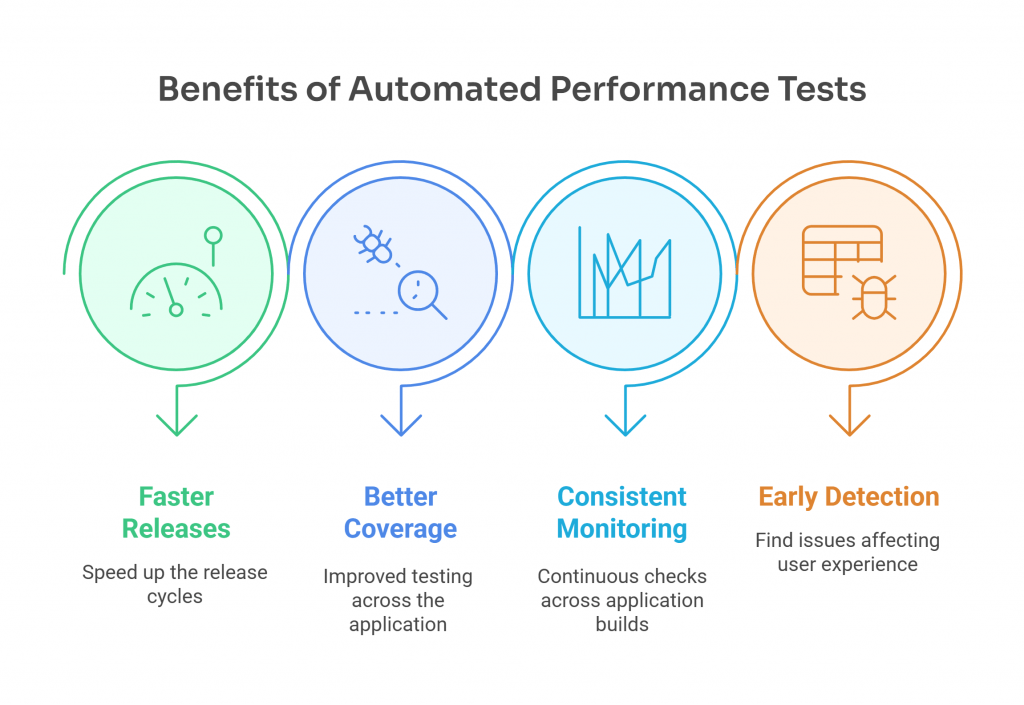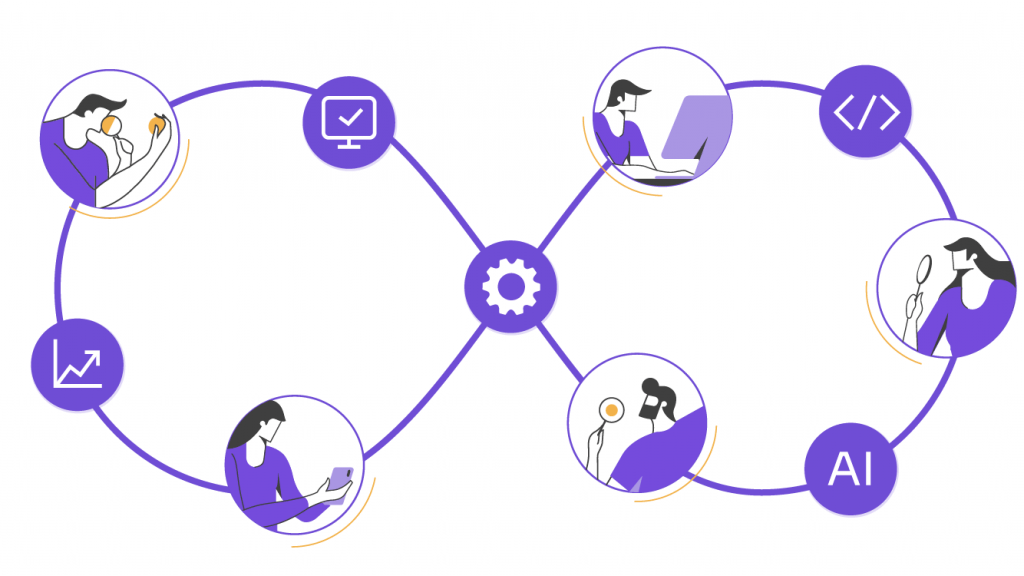Struggling with slow apps? Boost speed, prevent crashes, and optimize battery life with mobile app performance testing. Automate and excel with Abstracta!


Users expect apps to load quickly, respond promptly to their interactions, and operate smoothly without draining device resources. Performance issues like slow load times, crashes, or excessive battery consumption can frustrate users, leading to negative reviews and lost revenue.
To stay competitive, you need a solid mobile app performance testing strategy.
According to the DIGITAL 2025: GLOBAL OVERVIEW REPORT by Data Reportal, the number of unique mobile users has reached 5.78 billion as of the beginning of 2025. This indicates that 70.5 percent of the global population now uses a mobile device.
Prioritizing consistent app performance supports long-term user retention. So, as mobile apps continue to dominate user attention, businesses must prioritize mobile application performance to move forward in a crowded marketplace.
In this guide, we’ll explore best practices, essential tools, and testing methods to help you optimize performance, enhance user experience, and avoid costly failures.
Need expert support? Dive into our Mobile App Testing Services!
Contact us to boost a flawless user experience.
Types of Mobile Apps


Understanding the diverse categories of mobile apps is essential for both developers seeking to create impactful solutions and users navigating the vast app stores in search of solutions tailored to their needs. Let’s explore some of the mobile application types.
Types of Mobile Applications Based on Development Approach
- Native Apps: These are built for specific platforms, like iOS or Android apps. They offer the best performance and access to mobile device-specific features.
- Web Apps: These are accessed through a mobile browser and are essentially websites optimized for mobile viewing. They are platform-independent but may have limited access to device features.
- Hybrid Apps: These combine elements of both native and web apps.
- Progressive Web Apps (PWAs): These are web applications that use modern web capabilities to provide a user experience similar to that of mobile native apps.
- Cross-Platform Apps: These are developed using frameworks that allow the same codebase to be deployed across multiple platforms.
Types of Mobile Applications Based on Use Case
- Enterprise Apps: These are designed for use within organizations to improve productivity, communication, or specific business processes.
- Consumer Apps: These are aimed at general consumers and can cover a wide range of functionalities such as social networking, entertainment, shopping, health, and fitness, among others.
- Gaming Apps: These are specifically designed for gaming purposes and can range from simple puzzle games to complex multiplayer experiences.
- Utility Apps: These serve a specific function or solve a particular problem for users. Examples include weather apps, calculators, file managers, and QR code scanners.
Empower your testing strategy with Abstracta Copilot, our AI-powered assistant. Achieve 30% more productivity while reducing costs and boosting quality.
What is Performance Testing in Mobile?


Mobile app performance testing is a critical aspect of app development. It involves assessing how well apps perform under various conditions, including different network speeds, device types, and user loads.
Types of Performance Testing for Mobile Apps
Testing mobile apps involves different test types that evaluate startup time, speed, responsiveness, and reliability to align performance with user expectations. A thorough performance testing strategy helps align outcomes with expectations under realistic conditions.
Let’s explore some key types of performance tests in the mobile app development process:
- Load Testing: Evaluates app performance under normal and peak usage. Simulates high concurrent user loads to identify bottlenecks and enable responsiveness during heavy usage.
- Stress Testing: Pushes the mobile app to its limits with extreme conditions like high traffic or resource constraints. Assesses stability and resilience, uncovering potential crashes or slowdowns.
- Endurance Testing: Assesses app performance over time to measure stability and resource usage. Identifies memory leaks, battery drain, or performance degradation during prolonged use.
- Compatibility Testing: Confirms a mobile app functions across devices, operating systems, and network conditions. Identifies compatibility issues for specific environments.
- Network Testing: Evaluates app performance under varied network conditions. Simulates real-world scenarios to validate responsiveness and reliability.
- Usability Testing: Focuses on overall user experience, including performance and intuitiveness. Gathers feedback to identify issues affecting user satisfaction.
- Client-Side Performance Testing: Measures performance from the user’s perspective by assessing app start-up time, UI responsiveness, rendering speed, and device resource usage. Identifies issues that impact the end-user experience on various devices and operating systems.
Mobile App Performance Testing Checklist


Optimal performance is paramount to delivering a seamless user experience and staying ahead of the competition. To achieve this, developers must adopt a strategic approach when testing performance that encompasses a wide range of factors.
- Define Performance Goals and Metrics: Determine the key performance indicators (KPIs) such as response time, latency, throughput, and resource utilization, and establish benchmarks for acceptable performance levels based on industry standards.
- Identify Different Devices and Platforms to Test: List the devices, operating systems (OS), and versions the mobile app will support, including various screen sizes, resolutions, and hardware configurations to facilitate compatibility testing.
- Plan Test Scenarios: Define realistic user scenarios covering different functionalities and usage patterns. Include real-world scenarios for normal usage, peak loads, and extreme conditions to cover all performance aspects, while also validating compliance with app store guidelines to avoid rejections or delays.
- Select Testing Tools: Choose appropriate tools for load and stress testing, network emulation, client-side performance testing, and monitoring. Also, aim to support compatibility with target platforms and the ability to generate comprehensive reports.
- Prepare the Test Environment: Set up test environments that mirror production conditions as closely as possible, and configure network conditions, including bandwidth, latency, and packet loss, for realistic testing.
- Perform the Tests: Execute load, stress, endurance, compatibility, network, client-side, and usability tests to evaluate application performance, stability, compatibility, and user experience across various scenarios and conditions.
- Perform the Tests: Execute load, stress, endurance, compatibility, network, client-side, and usability tests when testing mobile applications, to evaluate application performance, stability, compatibility, and user experience across various scenarios and conditions.
- Iterate and Optimize: Implement necessary optimizations based on test findings to enhance your mobile app performance, and iterate the testing process to validate improvements and promote continual performance optimization.
- Document and Report: Document the testing process, including test scenarios, methodologies, tools used, and results, and generate comprehensive reports highlighting metrics, findings, and recommendations for stakeholders.
- Monitor Performance Post-Release: Implement monitoring tools to continuously monitor your mobile app’s performance post-release and proactively identify and address issues in real-time to maintain optimal application performance and user satisfaction.
By following this checklist, you can establish a robust mobile app performance testing strategy to make sure your application meets expectations for speed, responsiveness, and reliability.
Key Performance Indicators to Watch
To test with purpose, you need to know what success looks like. Key performance metrics give you a clear picture of how your app behaves—and where it might be falling short.
At Abstracta, we recommend focusing on a few core signals:
- App startup time: Affects first impressions and user retention.
- Response time: Key to perceived performance and flow.
- Resource usage: Helps monitor CPU, memory, and battery behavior.
- Throughput and error rates: Reveal backend/API reliability.
- Trends in performance data: Spot issues early and prioritize fixes.
Tracking these consistently helps you identify performance bottlenecks before they reach production.
Want to go deeper? Don’t miss our full article: Key Performance Testing Metrics Explained.
Top Mobile Performance Testing Tools


Performance testing tools are becoming more and more critical for accurately predicting system capacity, network performance, and building quality software. Choosing the right one for you can make a world of difference! Not only reducing costs but also improving overall quality.
There are open-source and proprietary tools. While open-source tools are valuable, proprietary testing tools offer robust features and dedicated support that can be indispensable in certain scenarios.
With these considerations in mind, let’s briefly explore some of the top testing tools that are suitable for mobile application performance testing.
1. Apptim


Apptim is a testing platform designed to optimize the client-side performance of mobile applications. Without the need to install SDKs or extra libraries, it provides in-depth performance data and reports with various app performance metrics, including mobile app launch times, battery consumption, CPU and Memory Usage, FPS (frames per second), UX response times, app crashes, and more.
It enables users to analyze app performance and user experience by connecting their own devices, using a device farm in the cloud, or an on-premise device lab. This way, Apptim empowers teams through detailed mobile app performance analysis across real devices and test environments.
Check out Apptim’s documentation to learn more about the tool.
2. Apache JMeter


Apache JMeter is an open-source tool for testing and measuring server-side performance. It simulates multiple users and analyzes throughput, latency, and other metrics across static and dynamic resources. It allows users to create test plans to simulate different scenarios, with multiple concurrent users sending requests to a target server and generating real-time reports.
3. JMeter DSL


JMeter DSL (Domain Specific Language) is an open-source library developed by Abstracta, which simplifies JMeter testing through coding, eliminating the need to learn a new language or incorporate new tools. It broadens JMeter’s user base, facilitates faster testing, and enhances software quality.
JMeter DSL streamlines integration of continuous performance testing into development pipelines, promoting shift-left testing and simplifying the application of engineering and software development skills to test development and maintenance.
You can expand on these benefits and more in our insightful JMeter DSL guide.
4. Gatling


Gatling is a robust tool for applications, APIs, and microservices, pivotal in anticipating slow response times and system crashes to improve time-to-market and user experience. It challenges system limits, identifying weak spots before they become real-world problems.
Check out our comprehensive review of Gatling to get more insights.
5. LoadRunner


LoadRunner offers comprehensive solutions for applications of all complexities, supporting various protocols and providing advanced scripting and reporting capabilities.
It empowers businesses to simulate virtual users, reproduce real-world loads, and identify bottlenecks to enhance overall application performance.
6. BlazeMeter


BlazeMeter is a cloud-based performance testing platform that enhances Apache JMeter with scalability, analytics, and a user-friendly interface. It simplifies mobile and web applications’ performance testing with real-time insights, scalability, and collaboration features for teams of all sizes.
7. NeoLoad


NeoLoad is a dynamic performance testing solution designed to accelerate testing cycles while maintaining result accuracy. Its user-friendly interface and JavaScript scripting cater to diverse users and emphasize team collaboration for result sharing and analysis.
It provides fast, automated performance testing, adaptable to modern application environments, addressing challenges in complex scenarios.
8. Azure Load Testing


Azure Load Testing is a managed cloud-based testing tool that simulates high-scale traffic for applications, aiding in performance optimization for developers, testers, and QA engineers. It works regardless of the hosting environment, seamlessly intgrating with various application types and supporting CI/CD workflows for automated testing and early issue detection.
In June 2023, we released a new feature in JMeter DSL that significantly simplifies the use of Azure Load Testing when scaling tests. Allowing performance tests developed with JMeter DSL to be run on Azure Load Testing.
Want to dive deeper into more performance testing tools, for both web and mobile?
Don’t miss this article! Top 10 Performance Testing Tools.
Automation in Mobile App Performance Testing: Why and How


Trying to manually test every device, every condition, every release? It’s not realistic. Today’s mobile teams need speed, repeatability, and real-world feedback—fast.
While manual testing still plays an important role, especially in exploratory and edge-case scenarios, relying solely on it can slow teams down and leave gaps.
Automate Mobile App Testing
When you automate mobile app testing, you unlock the ability to run tests continuously, detect regressions early, and spot trends you might otherwise miss.
Automating performance tests enables:
- Faster release cycles
- Better test coverage
- Consistent monitoring across builds
- Early detection of issues that hurt user experience
And with AI agents in the mix, your automated tests can do even more—detect patterns, adapt test plans, and flag anomalies without human prompting. AI agents can monitor usage patterns, adjust scenarios, and flag anomalies, while humans stay in control of the strategy, context, and refinement.
Here’s how automation, enhanced with AI, can work alongside manual testing to elevate your overall performance strategy:
| Task | Manual Testing | Automated + AI-Enhanced Testing |
|---|---|---|
| Test execution speed | Deliberate and selective | Continuous and scalable across conditions |
| Coverage across devices/networks | Focused on critical paths | Broad and repeatable over time |
| Detection of regressions | Relies only on tester expertise | Assisted by real-time AI pattern recognition |
| Integration in CI/CD | Often decoupled | Seamlessly embedded in pipelines |
| Strategic value | Insightful for UX and edge cases | Powerful when paired with human oversight |
Our approach isn’t about removing people from the loop. It’s about empowering experts with intelligent tools that learn, adapt, and support better decision-making.
Looking to scale your performance testing intelligently? Let’s co-design an automation strategy that fits your product, your goals, and your team.
The #1 AI-Native Test Automation Platform is here!
With mabl + Abstracta professional services, you get automation that fits your workflow — and a partner that’s already helped dozens of teams do it right.
👉 Book a Meeting
FAQs About Mobile App Performance Testing


Can JMeter Be Used for Mobile App Performance Testing?
JMeter can be used as a performance testing tool to simulate user loads and traffic patterns on mobile apps. It helps organizations validate mobile app quality by identifying bottlenecks and inefficiencies before deployment and monitoring stability and scalability after launch.
How Do You Measure App Performance?
App performance is measured through metrics like response times, throughput, error rates, and CPU usage, as well as how the mobile app performs under workload. Using realistic test data uncovers the app’s capabilities, validates scalability, and demonstrates resilience across devices, operating systems, and varying network conditions.
Why Is Server-Side Performance Testing Important for Apps?
Server-side performance testing is important because it evaluates how an app consumes backend resources and manages concurrent requests. Since server response time strongly influences user experience, these tests help identify bottlenecks, validate spike testing across different os versions, and improve overall app performance under peak usage.
How to Do Performance Testing of Mobile Apps?
Performance testing of mobile apps starts by defining KPIs like response time, resource usage, and network latency that reflect user experience. The process includes running load, stress, endurance, and compatibility tests on real devices and emulators to capture performance under real-world conditions, followed by continuous monitoring post-release.
Which KPIs Should You Track for Mobile App Performance?
KPIs for mobile app performance include load speed, crash frequency, and throughput validated through a performance test. Tracking these metrics helps align results with user expectations and prioritize improvements that impact overall experience.
How Do You Set Up Device and Network Simulation for Tests?
Device and network simulation for tests involves replicating operating system constraints, device specifications, and varying network conditions. This process uncovers hidden weaknesses and confirms stability in both normal and peak conditions.
How Can You Check Mobile Phone Performance?
Mobile phone performance can be checked by monitoring how the app consumes resources like CPU, memory, and battery. Testing under varying network conditions validates reliability during both normal and peak conditions.
How Is AI Applied in Mobile App Performance Testing?
AI in mobile app performance testing is applied to detect anomalies, predict potential failures, and optimize system behavior. It analyzes test data in depth and generates insights that elevate mobile app quality.
Which Tool Is Best for Mobile App Testing?
The best tool for mobile app testing is one that adapts to the operating system, project scale, and integration needs within a broader software testing strategy. Apptim combines AI-powered performance testing with expert services, helping enterprises identify bottlenecks faster, reduce costs, and deliver stable mobile experiences at scale.
How Can Apptim Benefit Your Mobile App Testing Strategy?
Apptim offers both desktop and CLI tools for comprehensive mobile performance testing. The desktop tool facilitates manual testing without complex IDEs, streamlining incident reporting and collaboration between developers and testers. The CLI tool seamlessly integrates into development pipelines for evaluating client-side performance on emulators and real mobile devices.
Additionally, Apptim’s platform provides proactive performance measurement and UX testing, enhancing productivity and mitigating performance risks pre-deployment.
How We Can Help You


With nearly 2 decades of experience and a global presence, Abstracta is a leading technology solutions company with offices in the United States, Chile, Colombia, and Uruguay. We specialize in software development, AI-driven innovations & copilots, and end-to-end software testing services.
We believe that actively bonding ties propels us further. That’s why we’ve forged robust partnerships with industry leaders like Microsoft, Datadog, Tricentis, Perforce BlazeMeter, Saucelabs, and PractiTest, empowering us to incorporate cutting-edge technologies. technologies.
By helping organizations like BBVA, Santander, Bantotal, Shutterfly, EsSalud, Heartflow, GeneXus, CA Technologies, and Singularity University we have created an agile partnership model for seamlessly insourcing, outsourcing, or augmenting pre-existing teams.
Visit our tailored solutions!
✅Performance Testing Services
✅ Mobile App Testing Services
Contact us to improve your mobile app performance.


Follow us on Linkedin & X to be part of our community!
Recommended for You
TOP 10 Best Performance Testing Tools
Tags In


Sofía Palamarchuk, Co-CEO at Abstracta
Related Posts
A Quick BlazeMeter University Review
A senior performance tester’s review of the new courses by BlazeMeter Last week, I was looking for fresh knowledge on performance testing, so I asked a teammate of mine if she knew of any courses I could take. She recommended I try BlazeMeter University which…
Black Friday 2020: Avoid E-Commerce Site Crashes and Slowness
Everything you need to know to technically prepare your website for Black Friday and Cyber Monday While it’s coming down to the wire for retailers to get their websites fully prepared for a successful holiday season, it’s not too late to optimize them in order…
Search
Contents
Categories
- Acceptance testing
- Accessibility Testing
- AI
- API Testing
- Development
- DevOps
- Fintech
- Functional Software Testing
- Healthtech
- Mobile Testing
- Observability Testing
- Partners
- Performance Testing
- Press
- Security Testing
- Software Quality
- Software Testing
- Test Automation
- Testing Strategy
- Testing Tools
- Work Culture







